Wildflowers, Grasses and Other Nonwoody Plants
Media
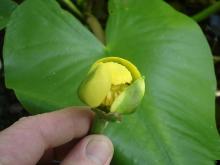
Species Types
Scientific Name
Nuphar advena (formerly N. lutea)
Description
Spatterdock is a native aquatic plant with deep yellow, saucer-or globe-shaped flowers to 3 inches across. It grows in ponds, lakes, and slow-moving to stagnant portions of streams, rivers, and spring branches.
Media
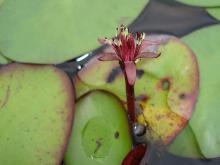
Species Types
Scientific Name
Brasenia schreberi
Description
Water shield is a long-stemmed aquatic plant with floating oval leaves that resemble small water lily leaves, only without a split. The stems and lower leaf surfaces have a thick, jellylike coating.
Media
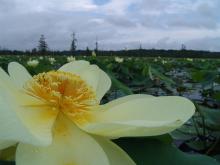
Species Types
Scientific Name
Nelumbo lutea
Description
American lotus is an aquatic plant with circular leaves that are held above water. The large yellow flowers have an interesting showerhead-like disk at the center.
Media
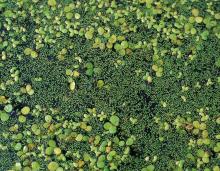
Species Types
Scientific Name
Lemna spp.; Spirodella spp.; Wolffia spp.
Description
Duckweeds are the smallest of the flowering plants. They consist of tiny, green, round, leaflike bodies that float on the water’s surface. They are an important food for waterfowl.
Media

Species Types
Scientific Name
Sagittaria spp.
Description
Arrowheads are aquatic plants with erect, usually arrow-shaped leaves and distinctive three-petaled flowers. They are often called duck potatoes because ducks, geese, and swans relish the tuberlike rootstocks.
Media
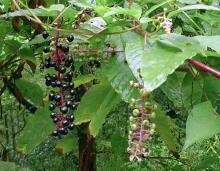
Species Types
Scientific Name
Phytolacca americana
Description
A tall, smooth, branching plant with red stems and juicy, dark purple berries, pokeweed is both toxic and a traditional edible potherb called poke salat. It is common statewide.
Media
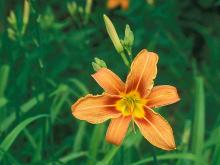
Species Types
Scientific Name
Hemerocallis fulva
Description
Native to Europe and Asia, orange day lily was widely planted by early settlers and has become widely naturalized in North America. The seeds don't mature in Missouri, so all the plants here are spread by root divisions.
Media

Species Types
Scientific Name
Lilium michiganense
Description
This native lily looks a lot like the Asian “tiger lily” that is commonly cultivated in gardens. Michigan lily, however, has leaves mostly in whorls and lacks the round “bulblets” that tiger lily forms in its leaf axils.
Media

Species Types
Scientific Name
Iris domestica (formerly Belamcanda chinensis)
Description
Blackberry lily has leaves like an iris, flowers like an Asian lily, and seeds that look like blackberries! Introduced as an ornamental, this self-seeding member of the iris family occurs on bluffs, roadsides, and old homesites.
Media

Species Types
Scientific Name
Tradescantia ohiensis
Description
Smooth spiderwort is the most common and widely distributed of Missouri's spiderworts. It has slender, straight or zigzag stems. The long, narrow leaves are folded lengthwise and attach to the stem in a thick node. The 3 petals of the triangular flower are blue, rose, purple, lavender, or white.
See Also
About Wildflowers, Grasses and Other Nonwoody Plants in Missouri
A very simple way of thinking about the green world is to divide the vascular plants into two groups: woody and nonwoody (or herbaceous). But this is an artificial division; many plant families include some species that are woody and some that are not. The diversity of nonwoody vascular plants is staggering! Think of all the ferns, grasses, sedges, lilies, peas, sunflowers, nightshades, milkweeds, mustards, mints, and mallows — weeds and wildflowers — and many more!





















